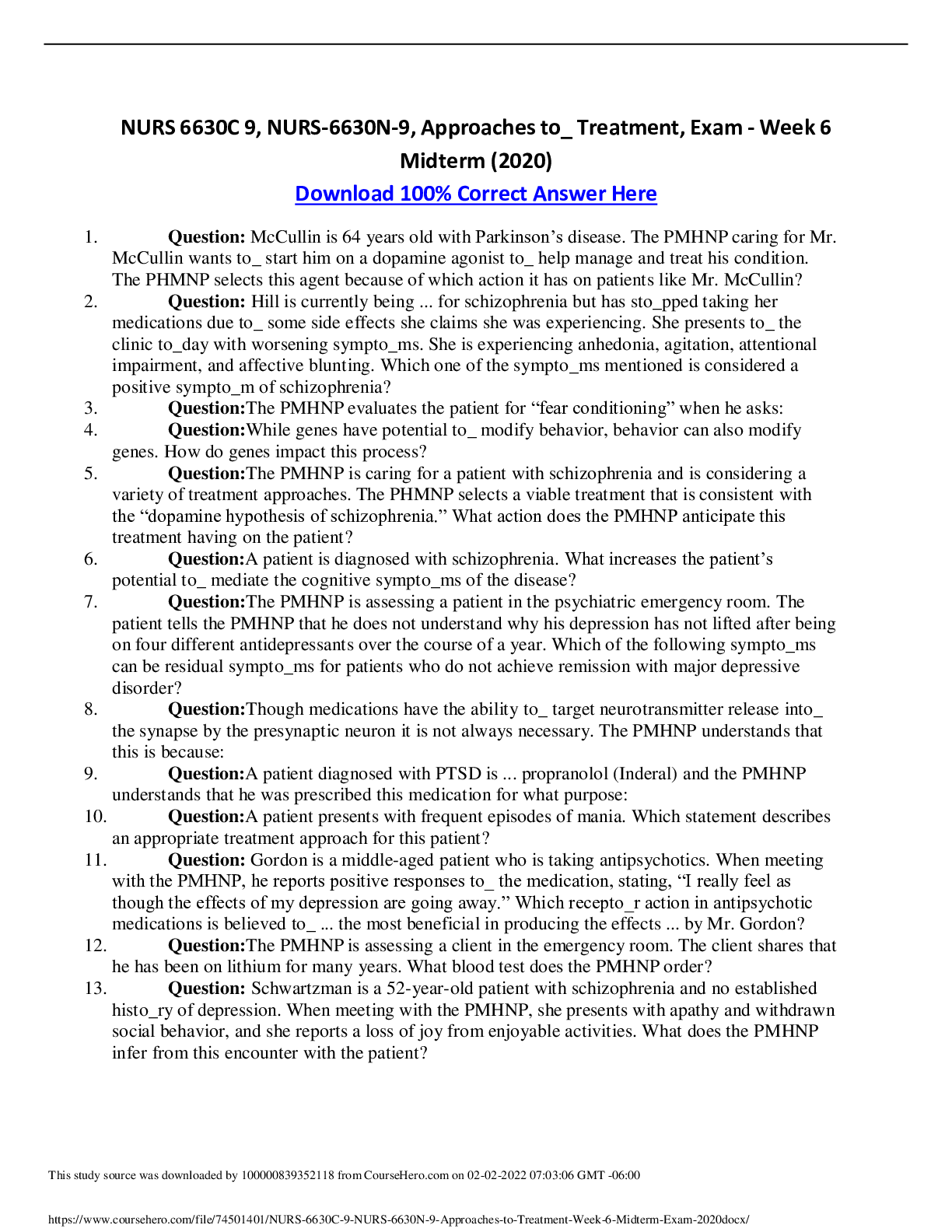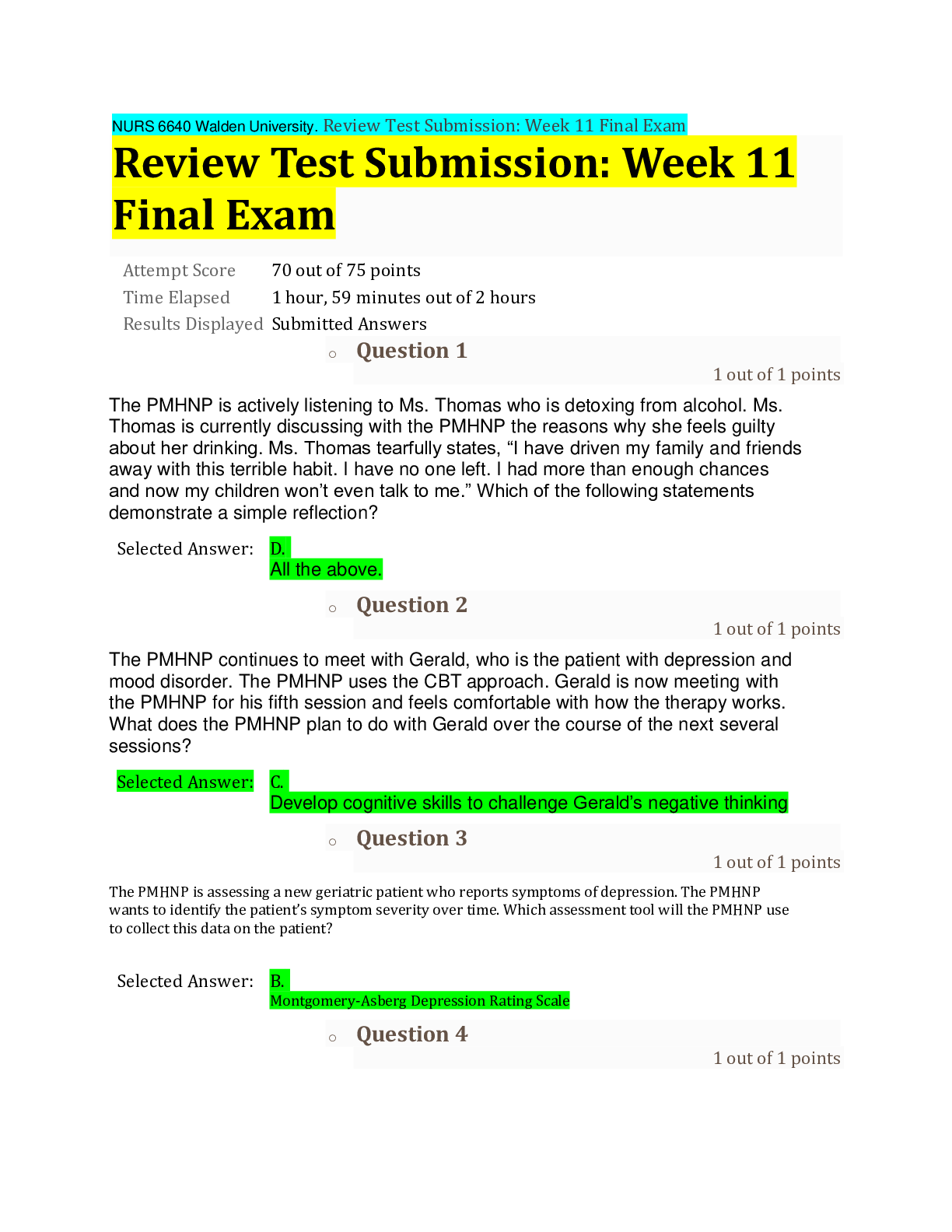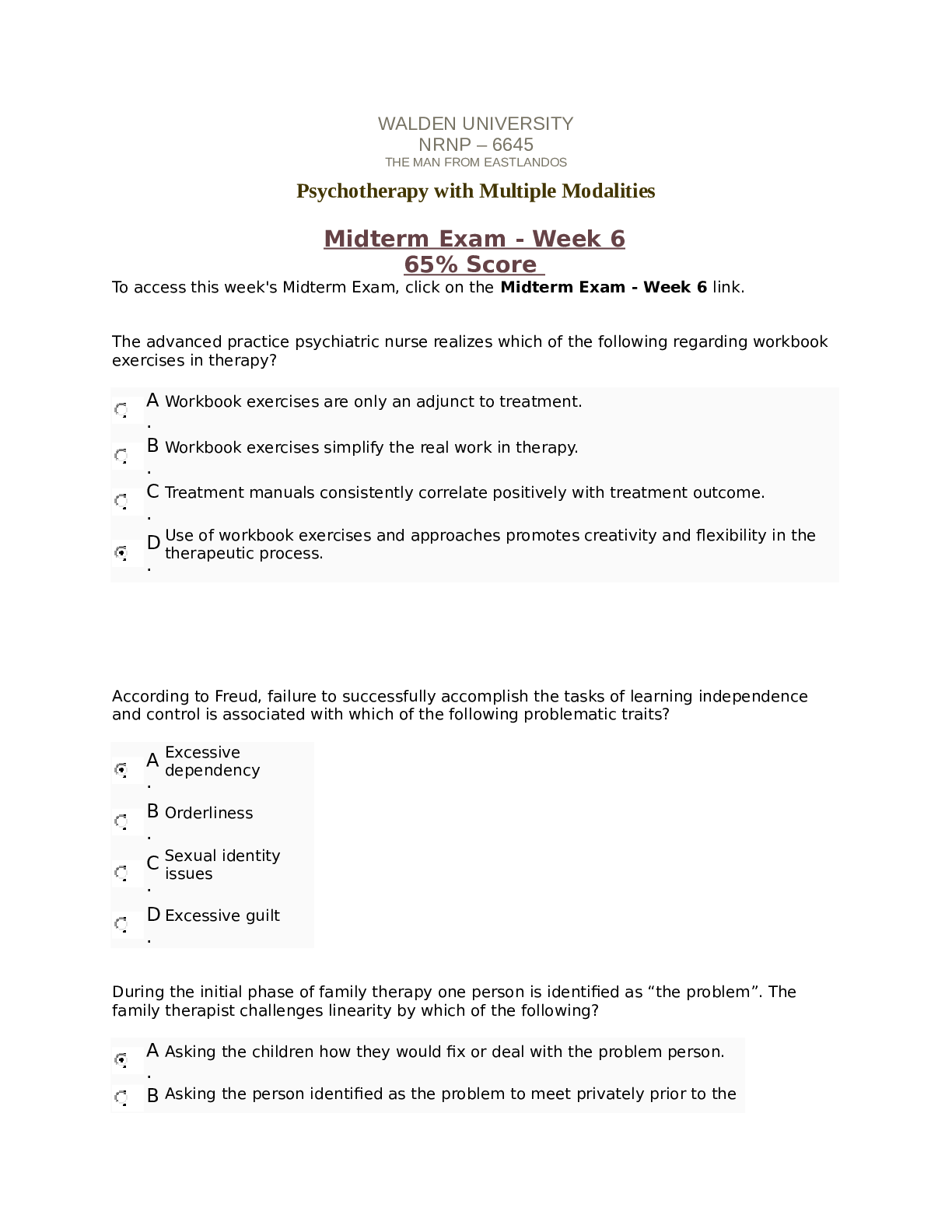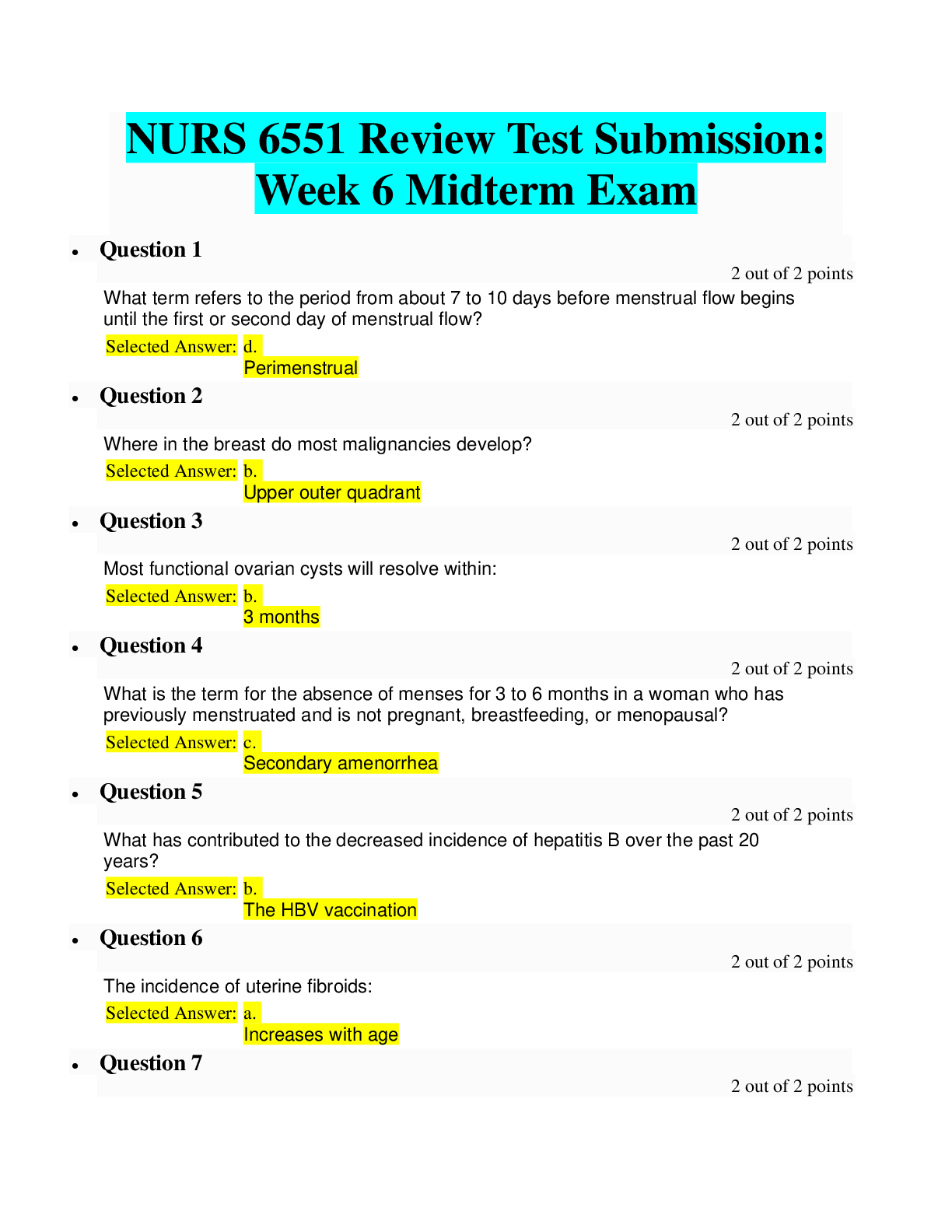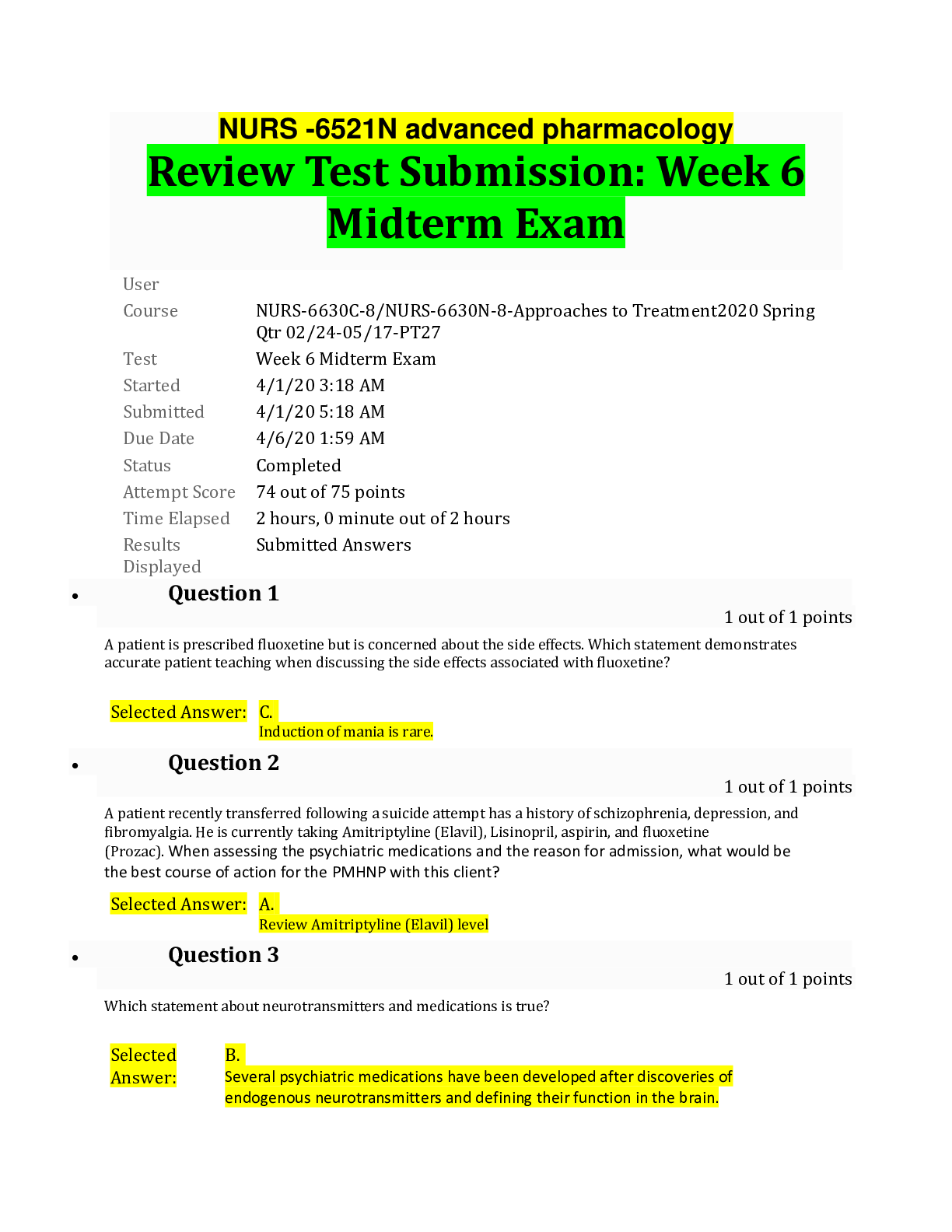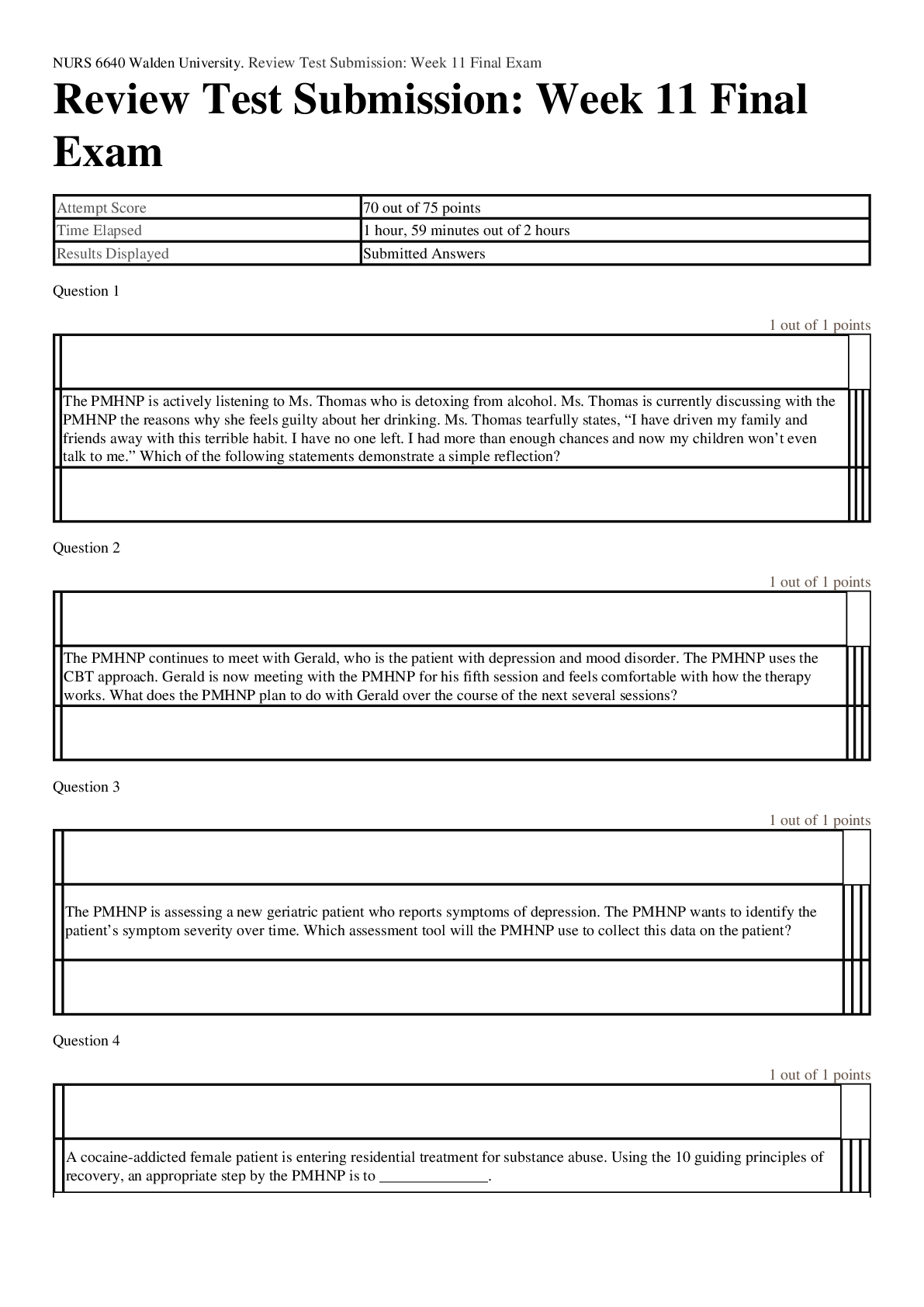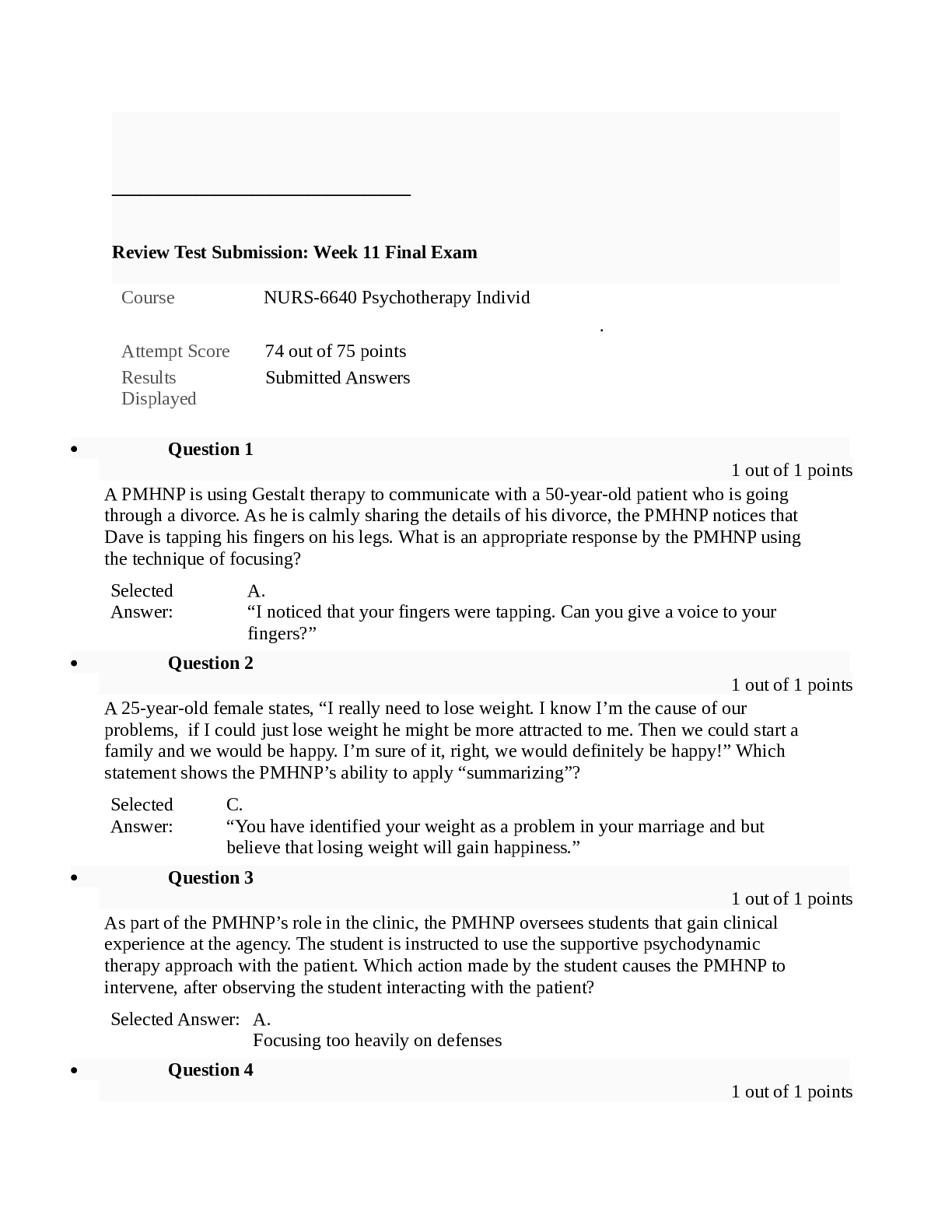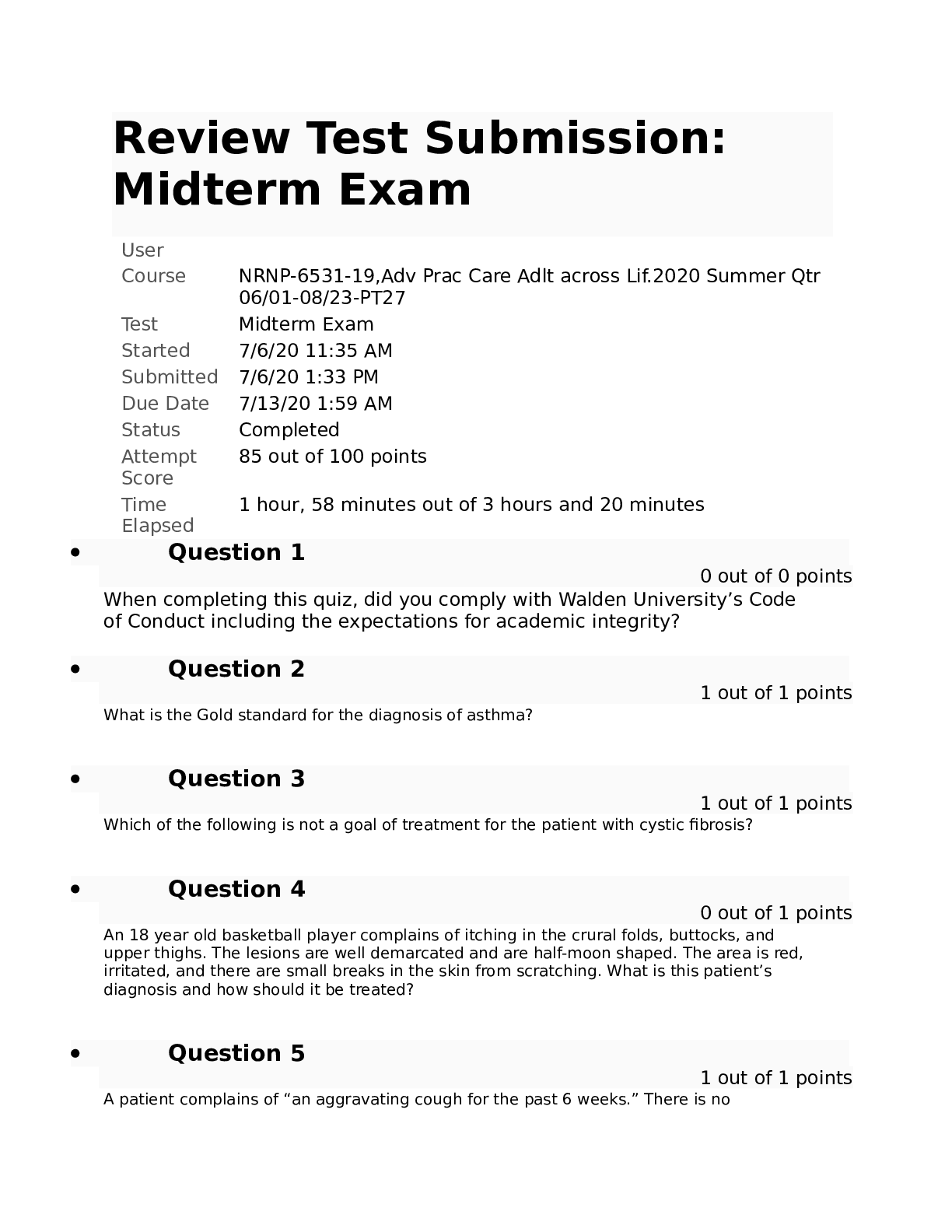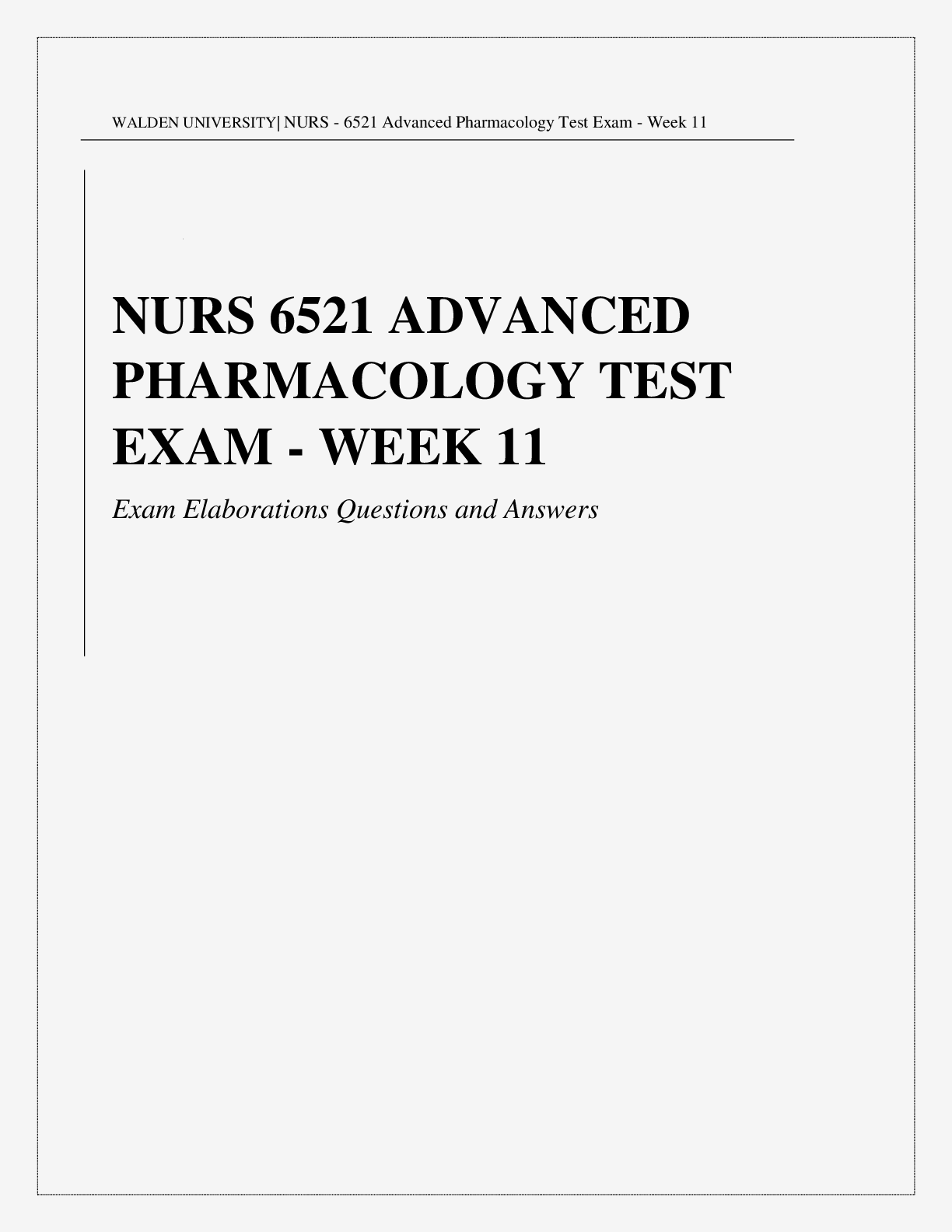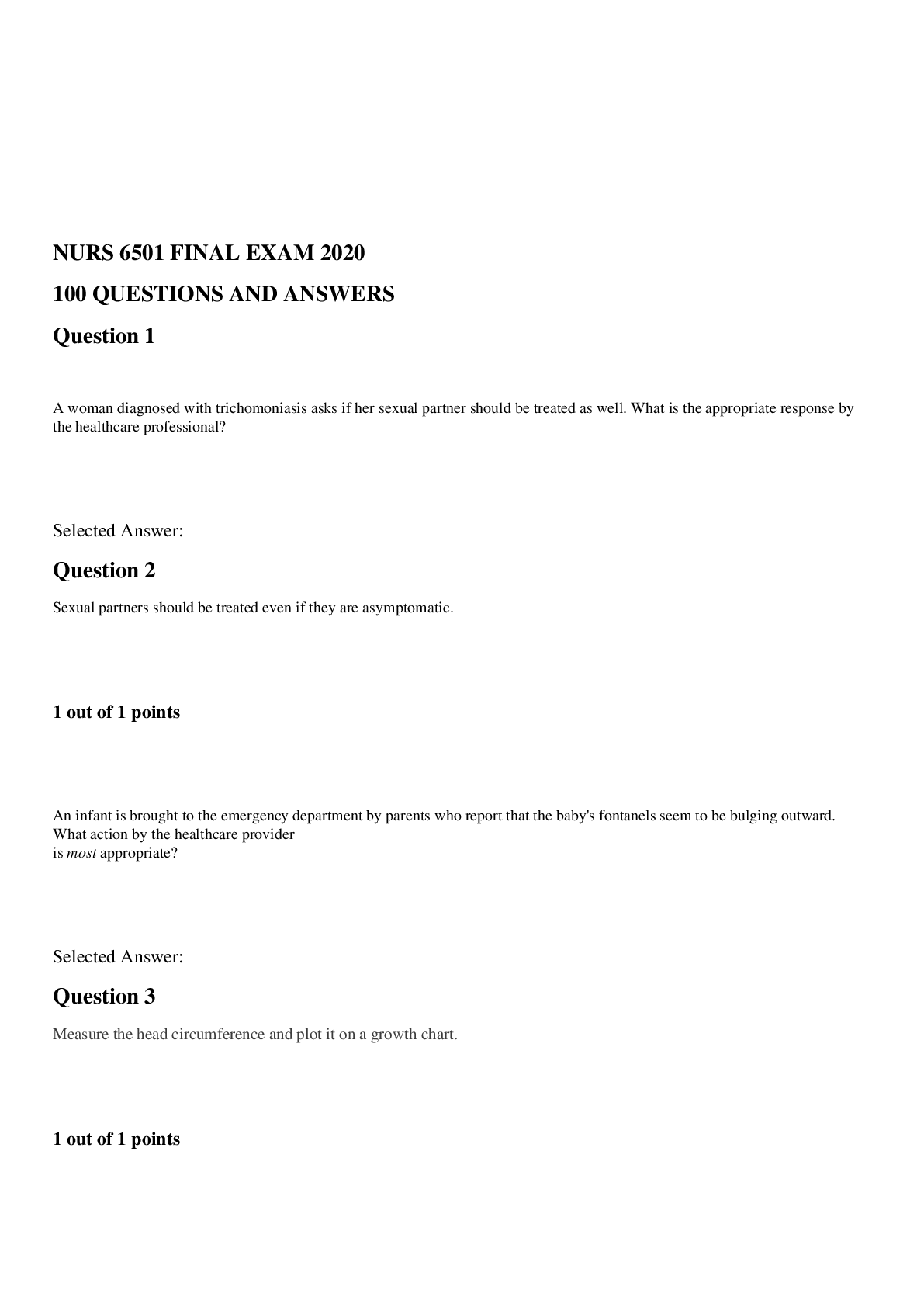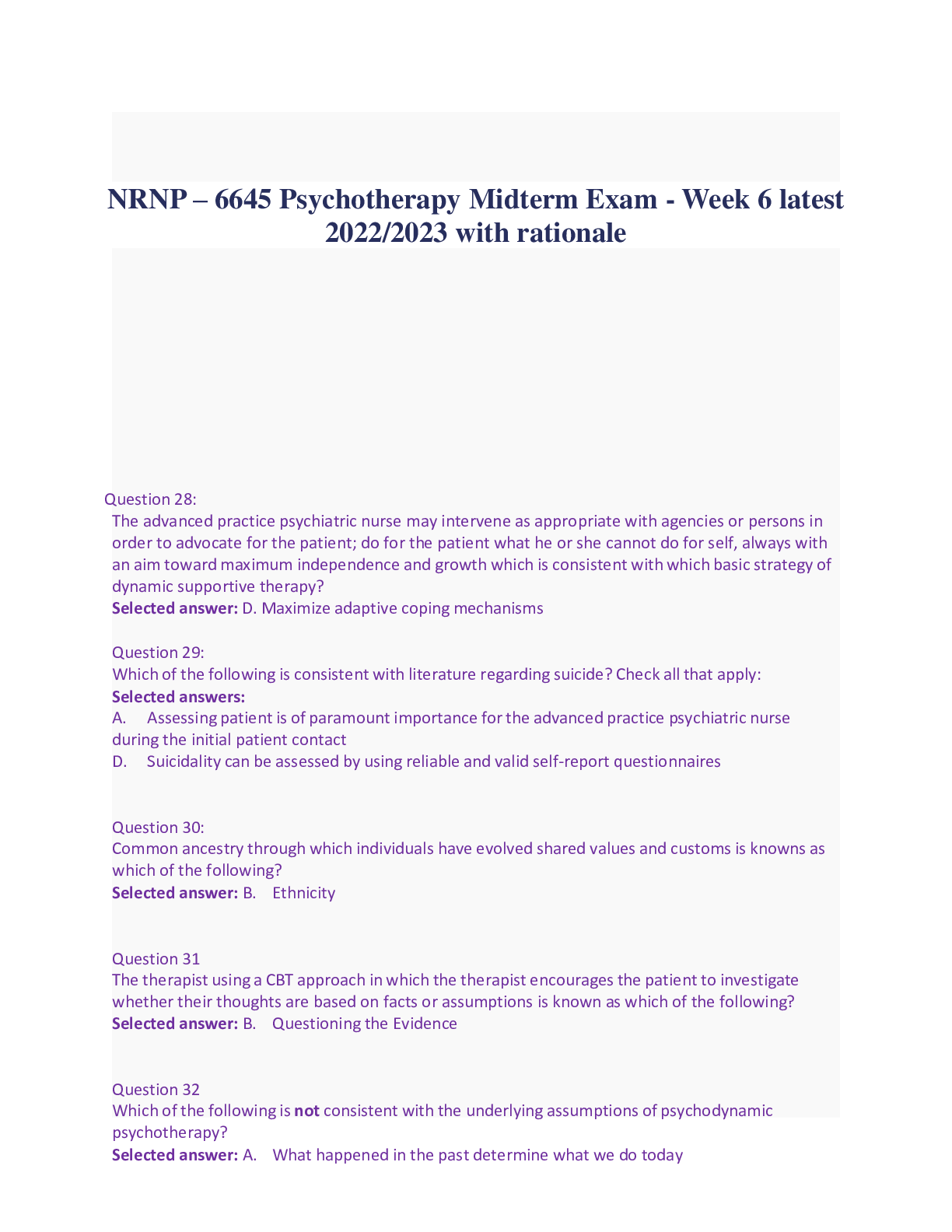*NURSING > EXAM > NURS 6501N Review Test Submission: Exam - Week 11 Final spring 2020,100% CORRECT (All)
NURS 6501N Review Test Submission: Exam - Week 11 Final spring 2020,100% CORRECT
Document Content and Description Below
NURS 6501N Review Test Submission: Exam - Week 11 Final spring 2020 Course NURS-6501N-34,Advanced Pathophysiology.2020 Spring Qtr 02/24-05/17-PT27 Test Exam - Week 11 Final ... Started 5/10/20 9:17 AM Submitted 5/10/20 10:36 AM Due Date 5/11/20 1:59 AM Status Completed Attempt Score 99 out of 100 points Time Elapsed 1 hour, 19 minutes out of 2 hours Results Displayed Submitted Answers ● Question 1 ● 1 out of 1 points ● Which cells function to maintain bone matrix? Selected Answer: Osteocytes ● Question 2 ● 1 out of 1 points ● Prenatal exposure to diethylstilbestrol (DES) can result in which type of cancer? Selected Answer: Vaginal cancer ● Question 3 ● 1 out of 1 points ● Which statement by the professor best describes acute respiratory distress syndrome (ARDS)? Selected Answ er: A pulmonary disease characterized by severe hypoxemia, decreased pulmonary compliance, and the presence of bilateral infiltrates on chest x-ray imaging ● Question 4 ● 1 out of 1 points ● In infectious mononucleosis (IM), what does the Monospot test detect? Selected Answer: Immunoglobulin M (IgM) ● Question 5 ● 1 out of 1 points ● A patient has been hospitalized for a large deep vein thrombosis and states he is the third person in his family to have this condition in the last 2 years. What response by the healthcare professional is most appropriate? Selected Answer: We can test your blood for factor V Leiden. ● Question 6 ● 1 out of 1 points ● The healthcare professor states that a patient has reached pain tolerance. What further information from the professor is most accurate? Selected Answer The patient cannot endure a higher level of pain intensity at this point. : ● Question 7 ● 1 out of 1 points ● A healthcare professional is teaching a community group about inherited disorders. What pattern of inheritance does the professional describe for sickle cell disease? Selected Answer: Inherited autosomal recessive disorder ● Question 8 ● 1 out of 1 points ● What is the link between major depression and cortisol secretion? Selected Answ er: Individuals with depression show that persistently elevated plasma cortisol levels can result in inflammation that is believed to trigger depression. ● Question 9 ● 1 out of 1 points ● A healthcare professional is planning a community event to reduce risk of cerebrovascular accident (CVA) in high risk groups. Which group would the professional target as the priority? Selected Answer: Hypertension ● Question 10 ● 1 out of 1 points ● A woman has been diagnosed with polycystic ovary syndrome but is confused because her pelvic ultrasound (US) was read as normal and did not show cysts. What response by the health care professional is most appropriate? Selected Answer : You do not need to have cysts on your ovaries to have this condition. ● Question 11 ● 1 out of 1 points ● A child has iron deficiency anemia. In addition to iron supplements, what else does the healthcare professional educate the parents on giving the child? Selected Answer: Vitamin C ● Question 12 ● 1 out of 1 points ● A person has been diagnosed with acute lymphocytic leukemia (ALL) that is positive for the Philadelphia chromosome. What statement by the healthcare professional is most appropriate? Selected Answ er: 1cWe are planning to get your disease in remission, but it will be hard. 1d ● Question 13 ● 1 out of 1 points ● Cystic fibrosis is characterized by which symptom? Selected Answer: Excessive mucus production ● Question 14 ● 1 out of 1 points ● A patient has primary immune thrombocytopenic purpura (ITP) and is hospitalized after a bleeding episode. What treatment does the healthcare provider anticipate being ordered for this patient? Selected Answer: Infusion of IVIG ● Question 15 ● 1 out of 1 points ● A hospitalized patient's lab work is as follows: WBC 2000, bands 14.8%, and segmented neutrophils 5. The healthcare professional calculates the patient's absolute neutrophil count (ANC). What action does the professional take next? Selected Answer: Implements protocols to prevent life- threatening infections ● Question 16 ● 1 out of 1 points ● A patient has been diagnosed with acute lymphocytic leukemia (ALL) and asks the healthcare professional to describe it. What description by the professional is most accurate? Selected Answ ALL is a progressive neoplasm defined by the presence of greater than 30% er: lymphoblasts in the bone marrow or blood. ● Question 17 ● 1 out of 1 points ● A healthcare professional is discussing breast feeding with a pregnant woman. Which beneficial substance does the professional tell the mother is found in breast milk? Selected Answer: IgA ● Question 18 ● 1 out of 1 points ● Clinical manifestations that include irregular or heavy bleeding, the passage of large clots, and the depletion of iron stores support which diagnosis? Selected Answer: Abnormal uterine bleeding ● Question 19 ● 1 out of 1 points ● What is the consequence of a splenectomy? Selected Answer: The number of defective cells in circulation increases. ● Question 20 ● 1 out of 1 points ● What congenital malformation is commonly linked to acute leukemia in children? Selected Answer: Down syndrome ● Question 21 ● 1 out of 1 points ● The student wants to know how the clinical manifestations and onset of juvenile idiopathic arthritis (JIA) differ from those of rheumatoid arthritis (RA) in adults. What answer by the healthcare professional is best? Selected Answer: JIA predominantly affects large joints. ● Question 22 ● 1 out of 1 points ● A student is learning about pelvic inflammatory disease (PID). What information does the student clarify with a study partner as being correct? Selected Answ er: Such an inflammation may result in permanent changes to the ciliated epithelium of the fallopian tubes. ● Question 23 ● 1 out of 1 points ● A newborn baby displays jaundice 20 hours after birth. What action by the healthcare professional is most appropriate? Selected Answer: Draw blood to measure total bilirubin. ● Question 24 ● 1 out of 1 points ● A patient reports joint stiffness with movement and joint pain in weightbearing joints that is usually relieved by rest. What treatment option does the health care professional discuss with the patient? Selected Answer: Exercise and weight reduction ● Question 25 ● 1 out of 1 points ● How does the epididymis become infected? Selected Answ er: The pathogenic microorganisms ascend the vasa deferentia from an already infected urethra or bladder. ● Question 26 ● 1 out of 1 points ● An infant has a continuous machine-type murmur best heard at the left upper sternal border throughout systole and diastole. The healthcare professional suspects a congenital heart disorder. What other assessment finding is inconsistent with the professional's knowledge about this disorder? Selected Answer: Thrill on palpation ● Question 27 ● 1 out of 1 points ● A patient has damage to the lower pons and medulla. What finding does the healthcare professional associate with this injury? Selected Answer: Flaccid response in the upper and lower extremities ● Question 28 ● 1 out of 1 points ● A baby is born with a myelomeningocele and needs urgent surgery to repair the defect. The parents want to take the baby home instead. What does the healthcare professional tell the parents about the purpose of this surgery? Selected Answer : 1cAdditional nervous system damage will occur the longer we wait. 1d ● Question 29 ● 1 out of 1 points ● A healthcare professional is caring for a patient diagnosed with aphasia. What action by the professional would be best in working with this patient? Selected Answer: Provide speech therapy. ● Question 30 ● 1 out of 1 points ● In which stage of syphilis would the following clinical manifestations be found: destructive skin, bone and soft tissue lesions, aneurysms, heart failure, and neurosyphilis? Selected Answer: Tertiary ● Question 31 ● 1 out of 1 points ● A patient is 8 hours postoperative after a long orthopedic procedure. The student asks why this patient is at particular risk of developing a thromboembolism. What response by the healthcare professional is best? Selected Answer: Patients tend to have venous stasis from orthopedic operations. ● Question 32 ● 1 out of 1 points ● The disruption in cellular adhesion observed in bullous impetigo is caused by an exfoliative toxin related to which organism? Selected Answer: Staphylococcus aureus ● Question 33 ● 1 out of 1 points ● A healthcare professional is reviewing a patient's laboratory results and sees that the patient has a low reticulocyte count and a high iron level. Which type of anemia does the professional associate these findings with? Selected Answer: Folate deficiency anemia ● Question 34 ● 1 out of 1 points ● A healthcare professional is caring for a patient who was rewarmed after suffering from hypothermia. What possible long-term complication will the professional continue to assess the patient for? Selected Answer: Renal failure ● Question 35 ● 1 out of 1 points ● A professor explains to a class that the reason lymph nodes enlarge and become tender during infection is because of what reason? Selected Answer: B lymphocytes proliferate. ● Question 36 ● 1 out of 1 points ● Local signs and symptoms of Hodgkin disease-related lymphadenopathy are a result of what? Selected Answer: Pressure and obstruction ● Question 37 ● 1 out of 1 points ● In immunoglobulin G (IgG) nephropathies such as glomerulonephritis, IgG is deposited in which location? Selected Answer: Glomerulus basement membranes ● Question 38 ● 1 out of 1 points ● A man has balanitis. What action by the healthcare professional is most appropriate? Selected Answer: Perform a finger stick for a blood glucose reading. ● Question 39 ● 1 out of 1 points ● A person has a vascular anomaly associated with a congenital malformation of dermal capillaries and has been told this lesion does not fade with age. What treatment options can the healthcare professional discuss with this person? Selected Answer: Pulsed dye laser ● Question 40 ● 1 out of 1 points ● A person comes to the healthcare clinic and reports night sweats and fever. The healthcare professional obtains a chest x-ray which shows a mediastinal mass. What other assessment or diagnostic test does the professional provide as a priority? Selected Answer: Listen to heart sounds. ● Question 41 ● 1 out of 1 points ● A patient had a seizure that consisted of impaired consciousness and the appearance of a dreamlike state. How does the healthcare professional chart this episode? Selected Answer: Complex focal seizure ● Question 42 ● 1 out of 1 points ● A healthcare professional had taught a pregnant woman about the risk of transmitting herpes simplex virus (HSV) from her to her fetus. What statement by the woman indicates the professional needs to provide more information? Selected Answ er: Neonatal infection with HSV rarely occurs in the intrapartum or postpartum period. ● Question 43 ● 1 out of 1 points ● An adult patient has been hospitalized with thrombocytopenia with a 3platelet count of 8000/mm What action by the healthcare professional is most appropriate? Selected Answer: Tell the patient not to get out of bed without assistance. ● Question 44 ● 1 out of 1 points ● A healthcare professional works with recent refugees. A mother brings in her children who have been diagnosed with iron deficiency anemia. What action by the professional is most appropriate? Selected Answer: Arrange to test for parasitic infections. ● Question 45 ● 1 out of 1 points ● A patient has been diagnosed with lithium toxicity. Which electrolyte imbalance does the healthcare professional correlate with this condition? Selected Answer: Hyponatremia ● Question 46 ● 1 out of 1 points ● A man reports to the healthcare professional that he had a sudden onset of malaise, low back pain, and perineal pain with high fever and chills, dysuria, nocturia, and urinary retention. What action by the healthcare professional is most appropriate? Selected Answer: Assist the man in obtaining a urine sample. ● Question 47 ● 1 out of 1 points ● A health care professional is caring for a patient admitted to the hospital with severe anorexia. What action by the health care professional would be most important? Selected Answer: Ensuring the patient is on a cardiac monitor ● Question 48 ● 1 out of 1 points ● A patient in the hospital has been receiving heparin injections. The platelet count on admission was 222,000/mm 3 and four days 3later is 113,000/mm What action by the healthcare professional is best? Selected Answer: Switch the heparin to lepirudin ● Question 49 ● 1 out of 1 points ● A child has phenylketonuria (PKU). The healthcare professional educates the parents on the special diet needed, telling them that children with PKU are unable to synthesize what? Selected Answer: Essential amino acid, phenylalanine, to tyrosine ● Question 50 ● 1 out of 1 points ● Compared with an adult, an infant has a greater content of extracellular fluid, as well as a greater rate of fluid exchange. What effect does this have on the fluid balance of a child compared with that of an adult? Selected Answer: The control of dehydration is more difficult. ● Question 51 ● 1 out of 1 points ● A parent brings a 10-year-old child to the clinic and reports a mottled appearance to the skin and legs cramps when the child is in physical education class. Physical assessment positive for upper extremity hypertension. What diagnostic testing or treatment does the healthcare professional prepare the family for? Selected Answer: An echocardiogram ● Question 52 ● 1 out of 1 points ● A student asks the professor to explain the jaundice that accompanies hemolytic anemia. Which statement is by the professor is most accurate? Selected Answe r: Heme destruction exceeds the liver's ability to conjugate and excrete bilirubin. ● Question 53 ● 1 out of 1 points ● A patient in the healthcare clinic reports fatigue, weakness, and dyspnea, as well as pale conjunctiva of the eyes and brittle, concave nails. What assessment by the healthcare professional is most appropriate for the suspected anemia? Selected Answer: Oral mucus membranes and tongue ● Question 54 ● 1 out of 1 points ● Which condition is considered a clinical cause of amenorrhea? Selected Answer: Failure to ovulate ● Question 55 ● 1 out of 1 points ● A child with acute poststreptococcal glomerulonephritis is voiding smoky, brown-colored urine and asks the healthcare professional to explain what causes it. What explanation by the professional is best? Selected Answer: Presence of red blood cells ● Question 56 ● 1 out of 1 points ● A criterion for a diagnosis of generalized anxiety disorder (GAD) is a period of excessive worrying that lasts for at least how many months? Selected Answer: 6 ● Question 57 ● 1 out of 1 points ● Which pain theory proposes that a balance of impulses conducted from the spinal cord to the higher centers in the central nervous system (CNS) modulates the transmission of pain? Selected Answer: Gate control theory (GCT) ● Question 58 ● 1 out of 1 points ● A child has osteosarcoma and the healthcare team is assessing for metastases. What diagnostic study would be the priority? Selected Answer: Chest x-ray or CT scan ● Question 59 ● 1 out of 1 points ● A patient has been exposed to prolonged high environmental temperatures and now shows signs of dehydration, decreased plasma volumes, hypotension, decreased cardiac output, and tachycardia. What treatment does the healthcare professional prepare to administer to this patient? Selected Answer: Give the patient plenty of cool fluids to drink. ● Question 60 ● 1 out of 1 points ● A healthcare professional advises a pregnant woman to add supplements of which nutrient to her diet to prevent birth defects? Selected Answer: Folate ● Question 61 ● 1 out of 1 points ● A parent asks the healthcare professional to explain why a child diagnosed with Tetralogy of Fallot squats frequently. What explanation by the professional is best? Selected Answer: Relieves hypoxia ● Question 62 ● 1 out of 1 points ● What are the clinical manifestations of testicular cancer? Selected Answer: Firm, nontender testicular mass ● Question 63 ● 1 out of 1 points ● A woman attempting to conceive tells the healthcare professional that she and her partner have intercourse when her basal body temperature (BBT) is around 37˚C (98˚F) without getting pregnant. What information does the professional give the woman? Selected Answer : Temperature alone is not the most accurate way to predict ovulation. ● Question 64 ● 1 out of 1 points ● A healthcare professional is seeing a patient with suspected schizophrenia. For which prenatal occurrence should the professional assess? Selected Answer: Viral infection ● Question 65 ● 1 out of 1 points ● What directly causes ovulation during the menstrual cycle? Selected Answer: Sudden increase of LH ● Question 66 ● 1 out of 1 points ● A healthcare professional is educating a community men's group on symptoms of benign prostatic hyperplasia (BPH). The professional relates that most symptoms are a result of which pathophysiologic condition? Selected Answer: Compression of the urethra ● Question 67 ● 1 out of 1 points ● A woman who is positive for hepatitis B is in labor. What action by the healthcare professional is most appropriate? Selected Answer: Immunize the newborn within 12 hours. ● Question 68 ● 1 out of 1 points ● An infant has been diagnosed with intussusception and the student asks the healthcare professional to explain the condition. What explanation by the professional is most accurate? Selected Answer : One part of the intestine telescopes into another section of the intestine. ● Question 69 ● 1 out of 1 points ● A patient has been hospitalized with Guillain-Barré syndrome (GBS). The patient asks how this could have occurred. What response by the healthcare professional is best? Selected Answer: It is often preceded by a viral illness. ● Question 70 ● 1 out of 1 points ● A healthcare professional wants to volunteer for a community education project to help prevent spinal cord injury. What activity would the professional most likely volunteer for? Selected Answer: Teaching older adults how to prevent trip-and-fall events ● Question 71 ● 1 out of 1 points ● A child has Duchenne muscular dystrophy. What complication does the healthcare professional teach the parents is most important to control? Selected Answer: Respiratory infection ● Question 72 ● 1 out of 1 points ● Which patient finding would lead the health care professional to assess the patient for inflammatory joint disease? Selected Answer: Systemic symptoms of inflammation ● Question 73 ● 1 out of 1 points ● A student asks the health care professional why obese people are at higher risk for hypertension than non-obese individuals. What response by the professional is best? Selected Answer: They produce more angiotensinogen. ● Question 74 ● 1 out of 1 points ● A person has been diagnosed with primary dysmenorrhea and wants to know why ibuprofen is a good choice for pain control. What response by the health care professional is best? Selected Answer: It reduces the production of prostaglandins in your body. ● Question 75 ● 1 out of 1 points ● A healthcare professional suspects a patient is brain dead. How would the professional assess for brain death? Selected Answer : Remove the patient's ventilator to see if spontaneous breathing occurs. ● Question 76 ● 1 out of 1 points ● A patient is in status epilepticus. In addition to giving medication to stop the seizures, what would the healthcare professional place highest priority on? Selected Answer: Providing oxygen ● Question 77 ● 1 out of 1 points ● A newborn has meconium ileus. What diagnostic test does the healthcare professional advise the parents about? Selected Answer: A sweat test ● Question 78 ● 1 out of 1 points ● Which statement is likely true regarding children being treated for cancer with radiation therapy? Selected Answer: They are at increased risk for developing childhood cancers. ● Question 79 ● 1 out of 1 points ● A student studying osteomyelitis and asks for an explanation of the term sequestrum. What response by the professor is best? Selected Answer: An area of devascularized and devitalized bone ● Question 80 ● 0 out of 1 points ● To quickly assess a patient's nervous system for dysfunction, what assessment should the healthcare professional perform as the priority? Selected Answer: Size and reactivity of pupils ● Question 81 ● 1 out of 1 points ● What is the most abundant class of plasma protein? Selected Answer: Albumin ● Question 82 ● 1 out of 1 points ● In acute hypothermia, what physiologic change shunts blood away from the colder skin to the body core in an effort to decrease heat loss? Selected Answer: Peripheral vasoconstriction ● Question 83 ● 1 out of 1 points ● A health care professional is teaching a group of college women about increasing calcium in the diet to prevent osteoporosis. A participant asks at what age is peak bone mass is reached in women. What response is best? Selected Answer: 30 years ● Question 84 ● 1 out of 1 points ● Which statement by the healthcare professional accurately describes childhood asthma? Selected Answ er: An obstructive airway disease characterized by reversible airflow obstruction, bronchial hyperreactivity, and inflammation ● Question 85 ● 1 out of 1 points ● A patient is in the intensive care unit and has intercranial pressure (ICP) monitoring. The patient's ICP is 17 mmHg. The healthcare professional notes that the chart indicates the patient is now in stage 1 intracranial hypertension. What assessment finding does the professional associate with this condition? Selected Answer: No significant change in ICP readings ● Question 86 ● 1 out of 1 points ● A healthcare professional is trying to lower a patient's body temperature by convection. What action by the professional will accomplish this? Selected Answer: Obtain a fan and set it to blow over the patient. ● Question 87 ● 1 out of 1 points ● How is gonorrhea transmitted from a pregnant woman to her fetus? Selected Answe r: Predominately through infected cervical and secretions during the birth process ● Question 88 ● 1 out of 1 points ● How should the healthcare professional reply when parents question why a computed tomographic (CT) scan of the head was not ordered for their 5-year-old child after a minor fall? Selected Answ er: Research suggests that repeated CT scans can increase the risk of developing brain cancer. ● Question 89 ● 1 out of 1 points ● A patient has ankylosing spondylitis. Which description of this condition by the health care professional is most accurate? Selected Answ er: Chronic inflammatory disease with stiffening and fusion of the spine and sacroiliac joint ● Question 90 ● 1 out of 1 points ● A healthcare professional is caring for a patient who has a spinal cord injury at T5. The patient exhibits severe hypertension, a heart rate of 32 beats/min, and sweating above the spinal cord lesion. How does the professional chart this event? Selected Answer: Autonomic hyperreflexia ● Question 91 ● 1 out of 1 points ● What is the effect of low plasma albumin? Selected Answ er: Osmotic pressure decreases; thus water moves from the capillaries to the interstitium. ● Question 92 ● 1 out of 1 points ● What initiates inflammation in acute poststreptococcal glomerulonephritis? Selected Answer: Immune complexes ● Question 93 ● 1 out of 1 points ● What diagnosis is given to parents when their infant's hip maintains contact with the acetabulum but is not well seated within the hip joint? Selected Answer: Subluxated hip ● Question 94 ● 1 out of 1 points ● A person has abnormally severe tooth decay and erosion of the tooth enamel. What problem should the health care professional assess the person for? Selected Answer: Bulimia ● Question 95 ● 1 out of 1 points ● A patient is admitted to the hospital with multiple myeloma (MM). Which diagnostic test should the healthcare professional assess as the priority? Selected Answer: Serum calcium level ● Question 96 ● 1 out of 1 points ● In the majority of children experiencing delayed puberty, what is the problem caused by? Selected Answer: Physiologic delays in maturation ● Question 97 ● 1 out of 1 points ● What does the student learn distinguishes kwashiorkor from marasmus? Selected Answe r: Subcutaneous fat, hepatomegaly, and fatty liver are present in kwashiorkor. ● Question 98 ● 1 out of 1 points ● Without prior exposure to an antigen, which cells are able to destroy some types of tumor cells and some virus-infected cells? Selected Answer: Natural killer (NK) cells ● Question 99 ● 1 out of 1 points ● A patient has chronic anemia associated with chronic renal failure. What substance does the healthcare professional tell the patient is needed to treat this anemia? Selected Answer: Erythropoietin ● Question 100 ● 1 out of 1 points ● A patient has pernicious anemia and asks the healthcare professional to explain the disease. Which statement by the professional is most accurate? Selected Answer: Your body cannot absorb vitamin B 12. ● Question 101 ● 0 out of 0 points ● When completing this exam, did you comply with Walden University's Code of Conduct including the expectations for academic integrity? Selected Answer: Yes Sunday, May 10, 2020 7:27:14 PM EDT [Show More]
Last updated: 1 year ago
Preview 1 out of 82 pages
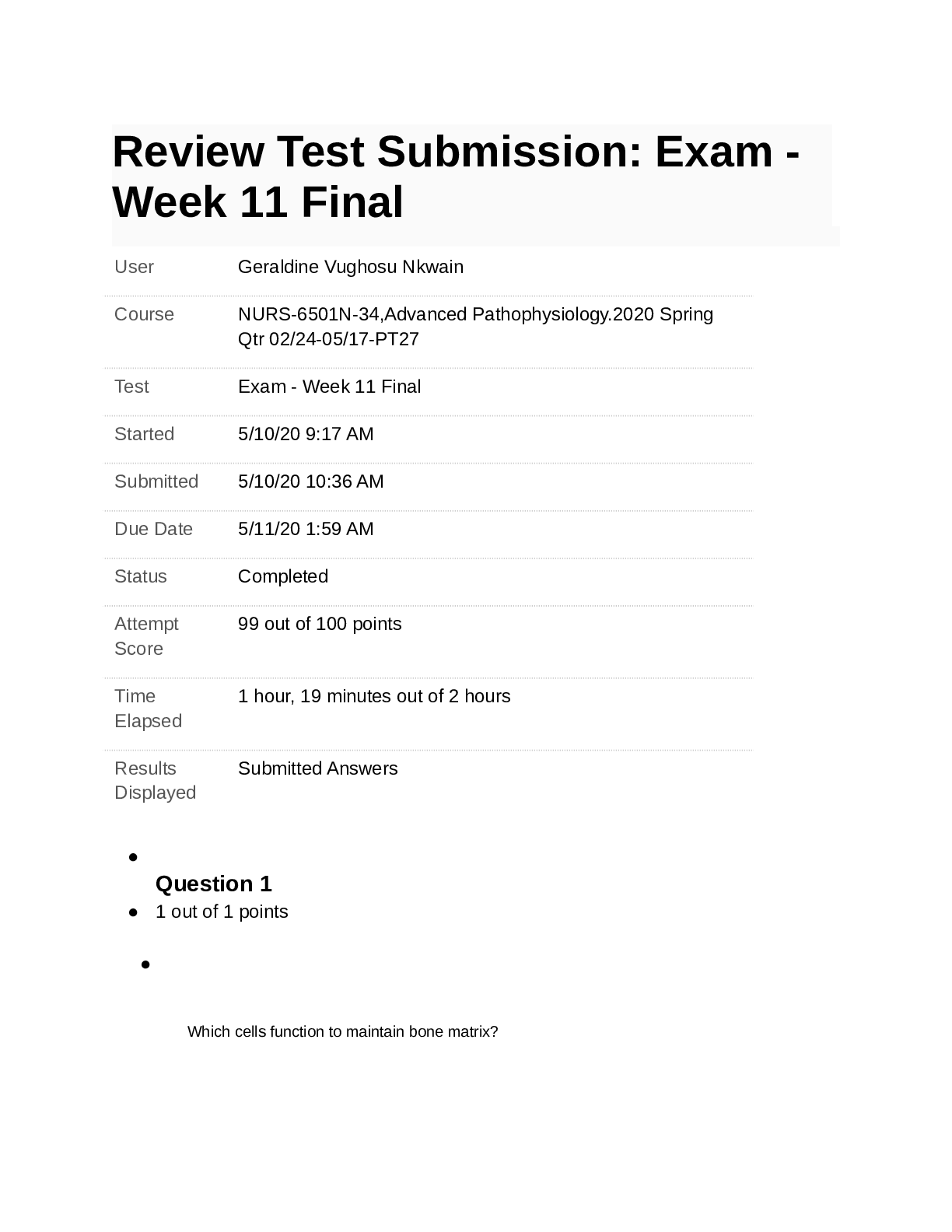
Reviews( 0 )
Document information
Connected school, study & course
About the document
Uploaded On
Feb 17, 2022
Number of pages
82
Written in
Additional information
This document has been written for:
Uploaded
Feb 17, 2022
Downloads
0
Views
21

















